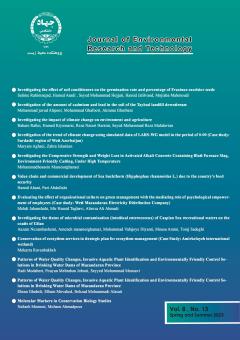-
-
-
Open Access Article
1 - The efficacy of multivariate regression models and GIS in Selecting SuitableSites for Rain Water Harvesting (Case Study: Tajareh Watershed)
maryam aghaie siamak dokhani ebrahim omidvarWater scarcity in arid areas is a serious crisis. The most important step in using rainwater collection systems is to locate suitable areas. In this research, three methods of multivariate regression model and GIS have been used to locate the on-site and off-site rainwa MoreWater scarcity in arid areas is a serious crisis. The most important step in using rainwater collection systems is to locate suitable areas. In this research, three methods of multivariate regression model and GIS have been used to locate the on-site and off-site rainwater collection method in Tejreh watershed. In this study, canopy, litter, rock and gravel, bare soil, CN, precipitation, slope and soil depth as independent variables and influence on in situ rainwater collection and maximum instantaneous discharge for non-in situ rainwater collection method The title of the dependent variable was considered. The multivariate regression model uses stepwise method, backward removal method, and forward method. And the standard step-by-step method, regression removal method, step-by-step method in collecting rainwater, non-in situ method have been used. The final results by matching the results of previous research show in step rainwater collection, stepwise method and between layers CN, soil, percentage of rock and gravel, and in non-in situ rainwater collection stepwise regression method Standard and among layers the percentage of litter, percentage of canopy, CN, slope, percentage of rocks and pebbles, amount of rainfall, percentage of bare soil and soil depth are known to be important in the equation. Finally, the importance of rain collection sites was divided into four classes: very good, good, medium and poor. Manuscript profile -
Open Access Article
2 - Investigation of the trend of climate change using simulated data of LARS-WG model in the period of 2011-2030 (Case study: Sardasht region of West Azerbaijan)
maryam aghaie zahra eslamianGiven the importance of climate change on the structure of the planet's environment and its in habitants, and will continue to try to understand as much as possible how climate change is happening. In this study in the climatic phase, daily data of minimum temperature, MoreGiven the importance of climate change on the structure of the planet's environment and its in habitants, and will continue to try to understand as much as possible how climate change is happening. In this study in the climatic phase, daily data of minimum temperature, maximum temperature, precipitation and sunshine hours of Sardasht synoptic station in the period 1996-1996 were simulated using LARS-WG statistical model and after ensuring the efficiency of this model in Simulation of meteorological parameters in Sardasht region, to study climatic parameters in climate change, data; Three scenarios A2 (maximum scenario), A1B (medium scenario) and B1 (minimum scenario) of HadCM3 model in the period 2030-2011 were scaled with LARS-WG small statistical model. The results showed that according to the estimation of LARS-WG model for the studied scenarios in the future periods, the average temperature of Sardasht watershed will increase by 4 degrees Celsius. The amount of precipitation also shows a 2% increase compared to the base period. The results also show that in general, the performance of Lars model in modeling the meteorological variables of the stations under study is appropriate and can be used to reconstruct the data of stations in the past or Extend this data to the next period. It can also be used to assess the future climate of the province on a local scale. Manuscript profile
List of Articles maryam aghaie
-
The rights to this website are owned by the Raimag Press Management System.
Copyright © 2017-2024


